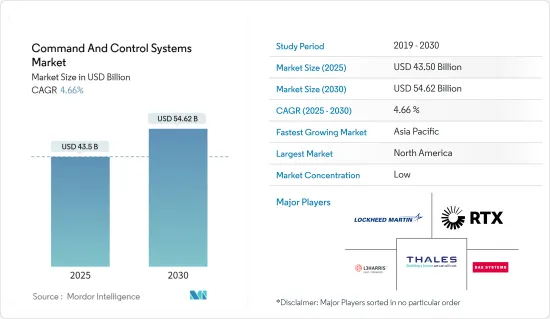PUBLISHER: Mordor Intelligence | PRODUCT CODE: 1686527

PUBLISHER: Mordor Intelligence | PRODUCT CODE: 1686527
Command And Control Systems - Market Share Analysis, Industry Trends & Statistics, Growth Forecasts (2025 - 2030)
The Command And Control Systems Market size is estimated at USD 43.50 billion in 2025, and is expected to reach USD 54.62 billion by 2030, at a CAGR of 4.66% during the forecast period (2025-2030).

Increasing political disputes and warfare situations, growing terrorism, and growing cross-border conflicts led to the strengthening of global defense capabilities. Increasing military expenditure facilitated the armies to focus more on procuring new generation C2 systems, as the capabilities of the existing C2 systems are not up to the industry benchmark. The ongoing military modernization programs and rising spending on procurement of advanced defense systems will drive the market during the forecast period.
During wartime, defense departments cannot include any obsolete technologies, especially in C4ISR systems, because these systems are used for communication, strategic planning, and decision-making. C2 systems are a crucial part of C4ISR systems, whose growth is expected to be very rapid. The ongoing R&D activities to develop advanced systems may provide growth opportunities for the market in the coming years. Satellite communications (SATCOM) became a firmly established part of modern military operations by providing enhanced capabilities for C2 in remote and austere environments. The growing use of SATCOM is expected to bring new opportunities for the market in the coming years.
However, command and control systems need to integrate with existing infrastructure, including legacy systems, communication networks, and hardware platforms. Integration is complex because it must ensure seamless interoperability and data exchange between diverse systems, which might developed by different OEMs or operate on different protocols. Such integration challenges can lead to project delays, cost overruns, and operational inefficiencies.
Moreover, constant investment in research and development for the latest C2 systems is essential for staying ahead of emerging threats and developing the latest solutions to counter them. Interoperability and scalability are key traits of the latest command and control systems, allowing them to adapt to changing operational environments.
Command and Control Systems Market Trends
Land Based Platform Will Showcase Remarkable Growth During the Forecast Period
The land-based command and control systems segment is estimated to hold the largest market share during the forecast period due to its high usage on the battlefield. The increasing number of military modernization programs and procurement of advanced defense systems by the defense forces drive the market growth. The growing military operations worldwide due to various geopolitical issues and the growth of terrorist and hostile activities increased the demand for building fixed-base control centers and land-based command headquarters.
The land-based C2 systems act as a communication bridge between troops and ground station personnel on the battlefield. For instance, in October 2023, Elbit Systems Ltd. subsidiary Elbit Systems Sweden AB was awarded a contract of USD 170 million to participate as an integration partner in the Swedish Army digitalization program LSS Mark. As the integration partner, Elbit Systems Sweden will integrate, install, maintain, and upgrade command and control systems on a variety of platforms, from command posts and vehicles to dismounted systems.
Thus, growing investment in the procurement of advanced command and control systems and an increase in annual defense budget allocation to infrastructure development of various countries drive the growth of the market land-based segment.
Asia-Pacific is Estimated to Show Remarkable Growth During the Forecast Period
Asia-Pacific will experience significant growth during the forecast period. The growth is attributed to growing defense expenditure and rising military modernization programs by countries like China, India, South Korea, and others. Increasing tensions between India and China over the line of control (LOC), rising cross-border conflicts, and growing terrorist activities across the region led to increased spending on the defense sector by Asian countries.
In addition, countries such as India, China, Japan, and Australia participate in several airborne, land, space, and naval modernization programs. For instance, in August 2022, Lockheed Martin Australia partnered with the Royal Australian Air Force (RAAF) and Defence Science and Technology Group (DSTG) to explore systems. It is to leverage artificial intelligence to support rapid decision-making at tactical levels of command and control across various domains.
Command and Control Systems Industry Overview
Additional Benefits:
TABLE OF CONTENTS
1 INTRODUCTION
- 1.1 Study Assumptions
- 1.2 Scope of the Study
2 RESEARCH METHODOLOGY
3 EXECUTIVE SUMMARY
4 MARKET DYNAMICS
- 4.1 Market Overview
- 4.2 Market Drivers
- 4.3 Market Restraints
- 4.4 Porter's Five Forces Analysis
5 MARKET SEGMENTATION
6 COMPETITIVE LANDSCAPE
7 MARKET OPPORTUNITIES AND FUTURE TRENDS




